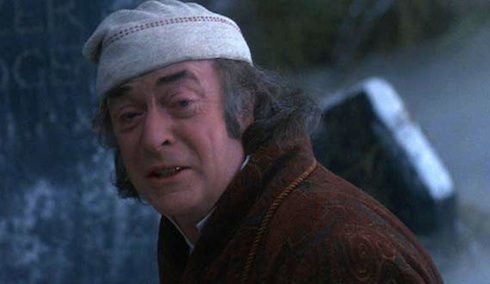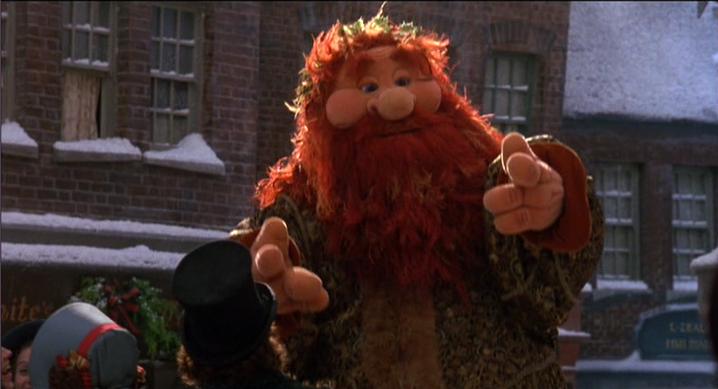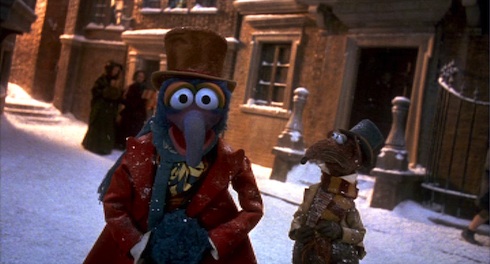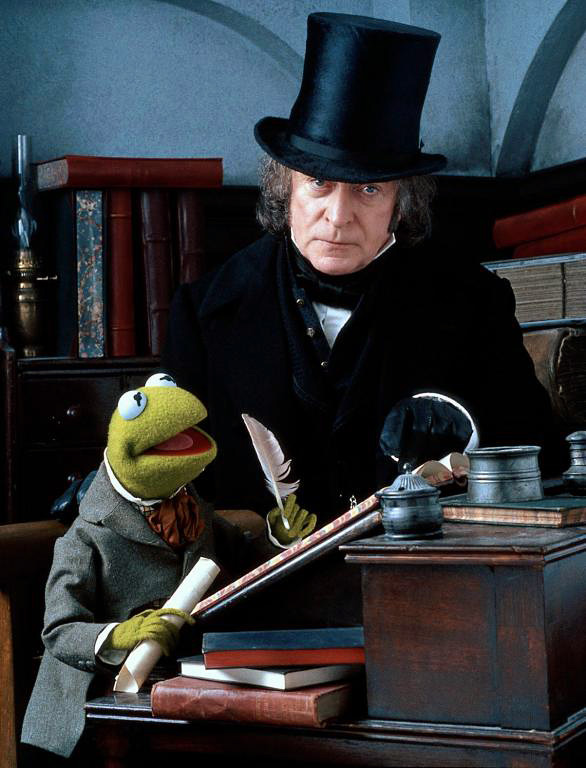When I say A Muppet Christmas Carol is sweet, I don’t only mean the movie is heartwarming and saccharine. It’s those things, too, but it’s also a film that delivers a uniquely badass adaptation of Charles Dickens’ ridiculously famous novella. Darker and less goofy than other Muppet flicks, A Muppet Christmas Carol manages to capture the phantasmagorical texture of the source material while at the same time turning out a bonafide family film, though not necessarily a kid’s movie. While you might read a child A Christmas Carol aloud, you probably wouldn’t give them the original novella for them to read on their own. And it’s the same with this movie. Despite its Hallmark Card exterior, A Muppet Christmas Carol might be the most adult of the Muppet films.
The Muppets themselves are what make a Muppet film great, but with A Muppet Christmas Carol it was as though the metafictional conceit that the Muppets were really just working actors was taken to a new level. The only Muppet who goes by his Muppet name here is Rizzo the Rat. And though Rizzo attempts to break the illusion right at the beginning by asserting that Gonzo is NOT Charles Dickens, few other overt references to the Muppets being Muppets is made. The human characters and the Muppet characters interact with no need for explanation or close examination. Kermit the Frog is playing Bob Cratchit, not Cratchit the Frog. (Though the rats in Scrooge’s office do mumble, “it was the frog’s idea” at one point.)
Overall though, Director Brian Henson and screenwriter Jerry Juhl play the whole Muppets-in-Dickens thing totally straight. At the end when Scrooge calls out to the boy on the street to buy him a turkey, he’s obviously speaking to a bunny rabbit, but Scrooge calls him “boy” anyway. It’s cute as hell, but it’s not cutesy. What this means is that the movie is somewhat subtle. An absurd claim, I know, particularly when we consider we’re talking about a musical! Not only does it have Muppets hanging out with Michael Caine, but also constant singing! How could this be remotely subtle? The writing and direction is part of it, but Caine is a big deal here too.

Like Connery, or other actors famous for their distinctive voices, there’s a tendency to assume someone like Michael Caine isn’t a subtle actor, and that his Scrooge would be over-the-top and ridiculous. He’s in a Muppet movie after all, so everything should be really cartoony, right? Nope! True, Caine’s Scrooge is initially cruel and unfeeling, but he’s not playing some kind of Mr. Hyde-style monster. Even before the jaunts through time with the various spirits, this Scrooge has some doubt and guilt built into Caine’s performance. It’s hard to prove this, but by the end of the film it’s not as though the color of his eyes have changed from red to blue like he’s the Grinch or something. Caine’s portrayal — particularly when he’s pleading with The Ghost of Christmas Yet to Come — is more real and more human than most other portrayals of Scrooge. (With the possible exception of maybe Patrick Stewart’s one-man-show.) However, because mostly non-human “actors” surround this Scrooge, the isolation of the character from humankind is effectively heightened. If you actually LIVED in a town full of Muppets with squeaky voices, you might turn into Scrooge, too! The point is, when Scrooge is being cruel to Muppets it’s pretty hard to watch, meaning when he starts being nice to them, it’s endlessly satisfying.
The literary mutability of the Muppets is on full display in this movie and the roles filled by our familiar characters are all perfect fits. When you hear the name Fezziwig, you naturally know that Fozzie Bear will be portraying the character Fozziwig in the Muppet version. Jacob Marley becomes two ghosts instead of one in this incarnation of A Christmas Carol, played by those wonderful critics Statler and Waldorf. Gonzo is great as the narrator of the whole story, and various other Muppets like Beeker and Bunsen fill in nice supporting roles.

It is notable though, that with the exception of Statler and Waldorft, the spirits which guide Scrooge on his journey are all creatures/Muppets unique to this movie. In fact, the only one of the three that looks remotely like a Muppet is the Ghost of Christmas Present, and even there, it’s clear this is a guy in suit with a Muppet head on top. These were good decisions though, because if overly familiar Muppets had been cast in these pivotal roles, it would have made the movie way too cheesy. One could almost see a version of this movie with Sam the Eagle as the Ghost of Christmas Yet to Come, but it would have been a different, zanier, and worse film.
I can’t say I’m someone who necessarily likes a lot of singing in their films. Real musicals are one thing, but an adaptation of a famous book into a musical with Muppets sort of sounds horrible on paper to me. And yet the songs are corny little earworms that don’t detract from the movie one bit. Could I have done without them? Sure. But the movie isn’t made just for me. It’s not as though this was an interpretation of A Christmas Carol with puppets from The Dark Crystal. It wasn’t that dark. It’s still the Muppets, so let them sing!

This film was one of the first Muppet projects to be released after Jim Henson’s death, and in many ways, to me, feels the closest to what he would have intended. Many of the Muppet movies preceding this one are on par in terms of wit and fun, but few that followed it can hold a candle to this. The source material helped, but if Michael Caine and Kermit the Frog ever decided to be in a movie again, I would bet all my shillings that it would be a huge hit. Maybe they should consider classic literature again. Muppet Moby Dick anyone?
[images via The Muppet Wiki]
This post originally appeared on Tor.com on November 17, 2011.
Ryan Britt is the staff writer for Tor.com. He seems to write about A Christmas Carol on this website a lot. (Batman-Dickens! Doctor Who-Dicknes! Dickens in SF!)










